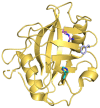Cyclophilins and Their Roles in Hepatitis C Virus and Flavivirus Infections: Perspectives for Novel Antiviral Approaches
- PMID: 34358052
- PMCID: PMC8308494
- DOI: 10.3390/pathogens10070902
Cyclophilins and Their Roles in Hepatitis C Virus and Flavivirus Infections: Perspectives for Novel Antiviral Approaches
Abstract
Cyclophilins are cellular peptidyl-prolyl isomerases that play an important role in viral infections, with demonstrated roles in the replication of hepatitis C virus (HCV) and other viruses in the Flaviviridae family, such as dengue virus (DENV) and yellow fever virus (YFV). Here, we discuss the roles of cyclophilins in HCV infection and provide a comprehensive overview of the mechanisms underlying the requirement for cyclophilins during HCV replication. Notably, cyclophilin inhibitor therapy has been demonstrated to be effective in reducing HCV replication in chronically infected patients. While the roles of cyclophilins are relatively well-understood for HCV infection, cyclophilins are more recently emerging as host factors for flavivirus infection as well, providing potential new therapeutic avenues for these viral infections which currently lack antiviral therapies. However, further studies are required to elucidate the roles of cyclophilins in flavivirus replication. Here, we review the current knowledge of the role of cyclophilins in HCV infection to provide a conceptual framework to understand how cyclophilins may contribute to other viral infections, such as DENV and YFV. Improved understanding of the roles of cyclophilins in viral infection may open perspectives for the development of cyclophilin inhibitors as effective antiviral therapeutics for HCV and related viruses.
Keywords: antiviral therapy; cyclophilins; flaviviruses; hepatitis C virus; virus-host interactions.
Conflict of interest statement
The authors declare no conflict of interest.
Figures





Similar articles
-
Emerging Roles of Cyclophilin A in Regulating Viral Cloaking.Front Microbiol. 2022 Feb 15;13:828078. doi: 10.3389/fmicb.2022.828078. eCollection 2022. Front Microbiol. 2022. PMID: 35242122 Free PMC article. Review.
-
Cyclosporine inhibits flavivirus replication through blocking the interaction between host cyclophilins and viral NS5 protein.Antimicrob Agents Chemother. 2009 Aug;53(8):3226-35. doi: 10.1128/AAC.00189-09. Epub 2009 May 18. Antimicrob Agents Chemother. 2009. PMID: 19451286 Free PMC article.
-
The role of immunophilins in viral infection.Biochim Biophys Acta. 2015 Oct;1850(10):2103-10. doi: 10.1016/j.bbagen.2014.11.011. Epub 2014 Nov 18. Biochim Biophys Acta. 2015. PMID: 25445708 Free PMC article.
-
The epidemiology and disease burden of children hospitalized for viral infections within the family Flaviviridae in China: A national cross-sectional study.PLoS Negl Trop Dis. 2022 Jul 5;16(7):e0010562. doi: 10.1371/journal.pntd.0010562. eCollection 2022 Jul. PLoS Negl Trop Dis. 2022. PMID: 35788743 Free PMC article.
-
Cyclophilins as modulators of viral replication.Viruses. 2013 Jul 11;5(7):1684-701. doi: 10.3390/v5071684. Viruses. 2013. PMID: 23852270 Free PMC article. Review.
Cited by
-
Illuminating Human Norovirus: A Perspective on Disinfection of Water and Surfaces Using UVC, Norovirus Model Organisms, and Radiation Safety Considerations.Pathogens. 2022 Feb 8;11(2):226. doi: 10.3390/pathogens11020226. Pathogens. 2022. PMID: 35215169 Free PMC article.
-
PPIH Expression Correlates with Tumor Aggressiveness and Immune Dysregulation in Hepatocellular Carcinoma.J Hepatocell Carcinoma. 2024 Dec 11;11:2453-2470. doi: 10.2147/JHC.S492420. eCollection 2024. J Hepatocell Carcinoma. 2024. PMID: 39679070 Free PMC article.
-
Emerging Roles of Cyclophilin A in Regulating Viral Cloaking.Front Microbiol. 2022 Feb 15;13:828078. doi: 10.3389/fmicb.2022.828078. eCollection 2022. Front Microbiol. 2022. PMID: 35242122 Free PMC article. Review.
References
-
- Blach S., Zeuzem S., Manns M., Altraif I., Duberg A.S., Muljono D.H., Waked I., Alavian S.M., Lee M.H., Negro F., et al. Global prevalence and genotype distribution of hepatitis C virus infection in 2015: A modelling study. Lancet Gastroenterol. Hepatol. 2017;2:161–176. doi: 10.1016/S2468-1253(16)30181-9. - DOI - PubMed
-
- Stanaway J.D., Flaxman A.D., Naghavi M., Fitzmaurice C., Vos T., Abubakar I., Abu-Raddad L.J., Assadi R., Bhala N., Cowie B., et al. The global burden of viral hepatitis from 1990 to 2013: Findings from the Global Burden of Disease Study 2013. Lancet. 2016 doi: 10.1016/S0140-6736(16)30579-7. - DOI - PMC - PubMed
-
- World Health Organization Global Hepatitis Report. [(accessed on 30 June 2021)]; Available online: https://www.who.int/publications/i/item/global-hepatitis-report-2017.
Publication types
LinkOut - more resources
Full Text Sources

